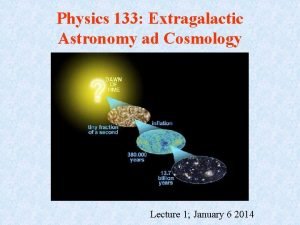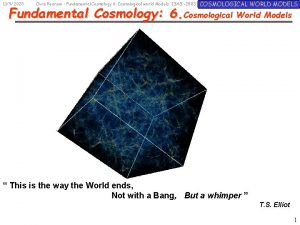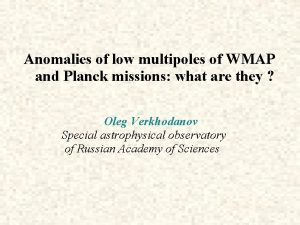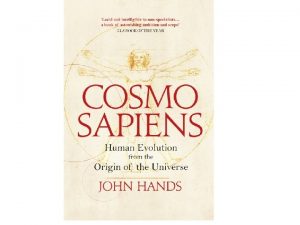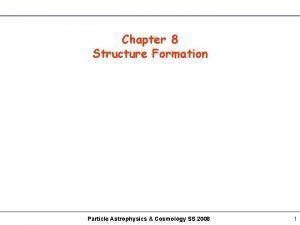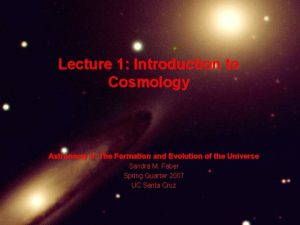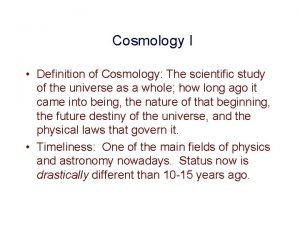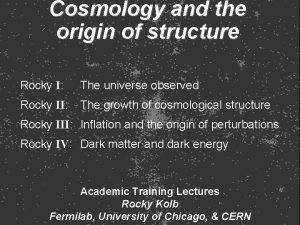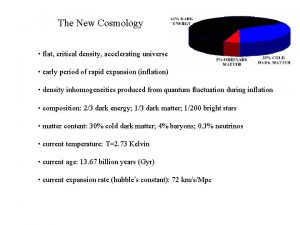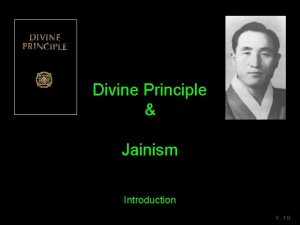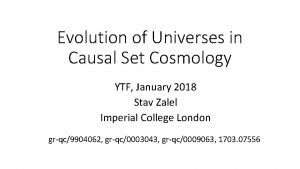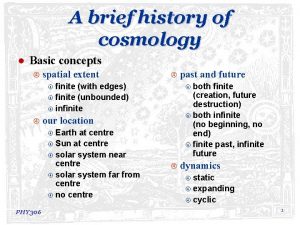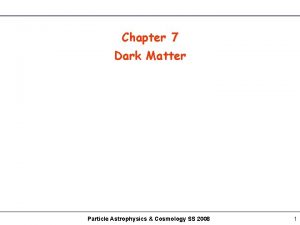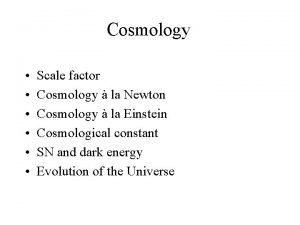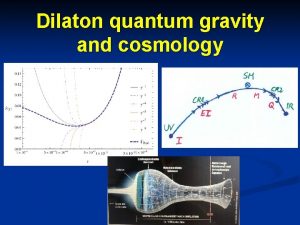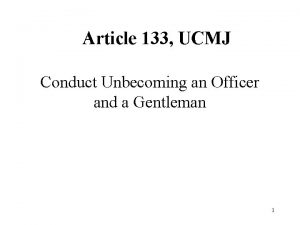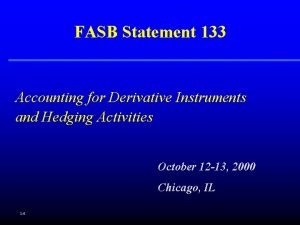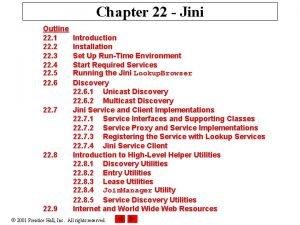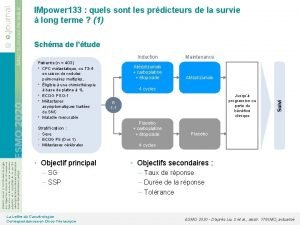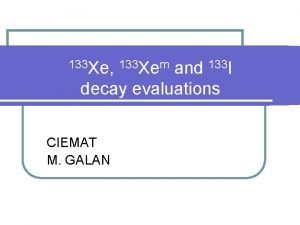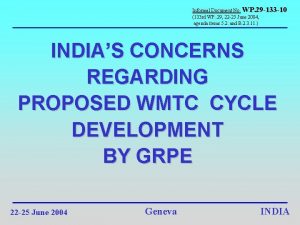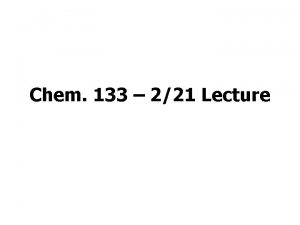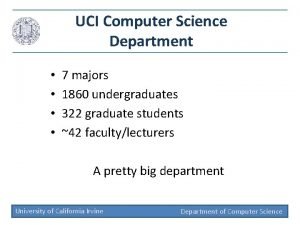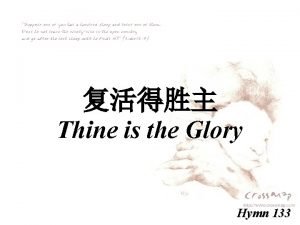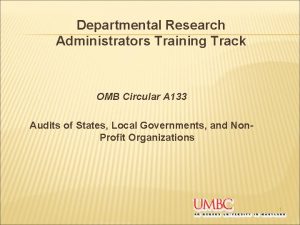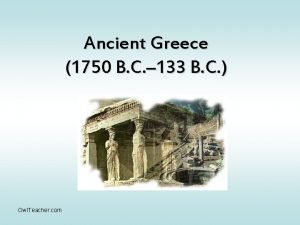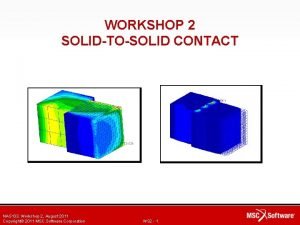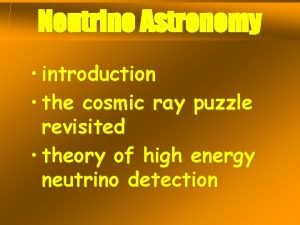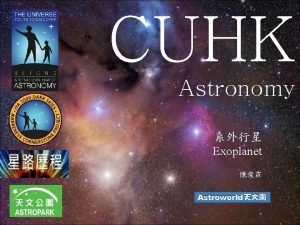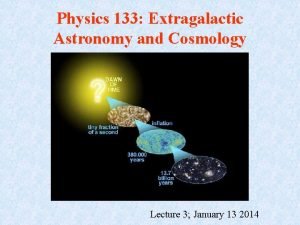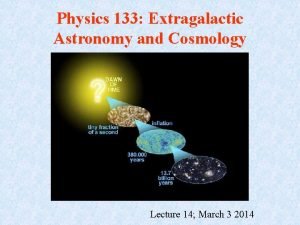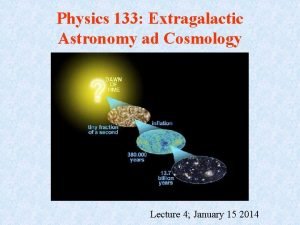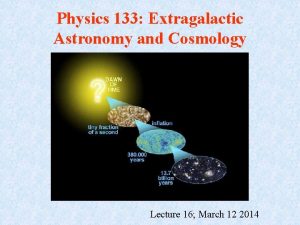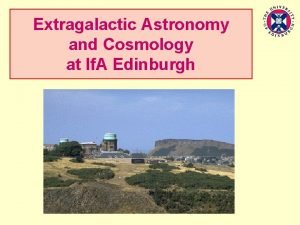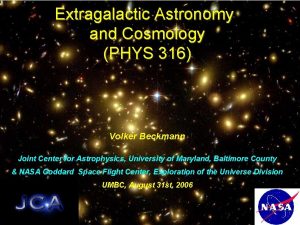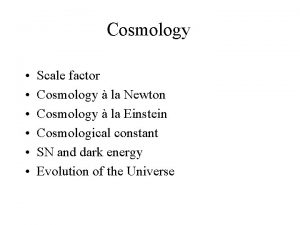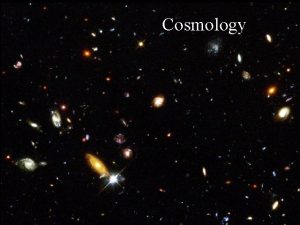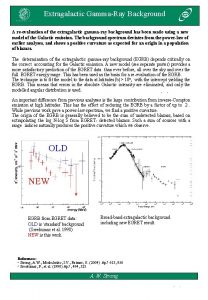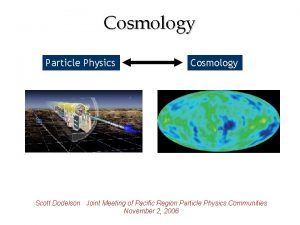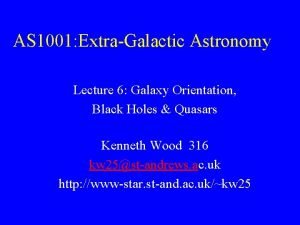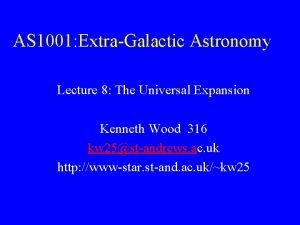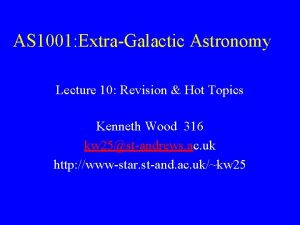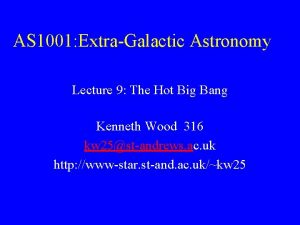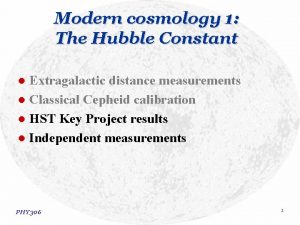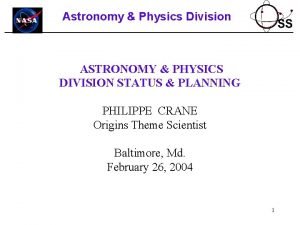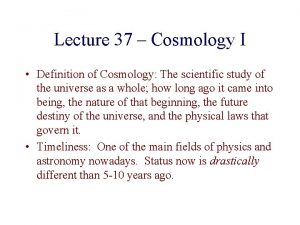Physics 133 Extragalactic Astronomy ad Cosmology Lecture 2


































![CMB properties [Blackboard] – Relevant Numbers – Expansion is adiabatic – Scaling of T CMB properties [Blackboard] – Relevant Numbers – Expansion is adiabatic – Scaling of T](https://slidetodoc.com/presentation_image_h/06cb2add760266d0b5f16bac751d907f/image-35.jpg)
















- Slides: 51

Physics 133: Extragalactic Astronomy ad Cosmology Lecture 2; January 8 2014

Previously on PHYS 133 • Units in astrophysics • Olbers’ paradox – The night sky is dark. Inconsistent with and eternal, static and infinite Universe

Homework: – Find on the webpage at http: //www. physics. ucsb. edu/~tt/PHYS 133/homewor k. html – Due Wednesday January 15

Outline: • Empirical foundations of the Big Bang theory. II: – Homogeneity and isotropy of the Universe. Copernican Principle – Expansion of the Universe. Hubble’s Law. – Cosmic Microwave Background. – Physical and chemical composition of the Universe.

Isotropy and homogeneity of the Universe • If we look far enough (100 Mpc) the universe is isotropic (i. e. invariant under rotation) • This is illustrated beautifully by the cosmic microwave background… What does the dipole mean in terms of reference frame?

Isotropy and homogeneity of the Universe. CMB Physics Nobel Prize 2006 to COBE and DMR PIs Mather & Smoot

Isotropy and homogeneity of the Universe. Galaxies far and away

Isotropy and homogeneity of the Universe. • One of the basic assumption of cosmologic is that we are observers in a random place. We are not in a special place in any way (Copernican Principle) • Therefore we CANNOT be at the center of the universe. Thus if the universe is invariant under rotation around a random point it must also be invariant under translation: homogenous. • ONLY ON LARGE SCALES. OF COURSE ON SMALL SCALES IT IS NOT!!!

Expansion of the Universe. Empirical facts. • In the early XX century, Hubble and Humason found out that the spectra of most galaxies are redshifted (the WAVELENGTH λ 0 of some spectral feature is moved to a longer wavelength λ) • The redshift z is the amount of shift towards longer wavelengths: Z=(λ-λ 0)/λ 0 • For z much smaller than 1, the redshift can be expressed as a velocity v=cz, by analogy with the Doppler effect.

Measuring Redshifts, an example. Ca. K 3933 Å Where is the feature now? Z=0 • Z=? • V=?

Measuring redshifts, an example. Ca. K 3933 Å Where is the feature now? Z=0 • Z=0. 1 • V=30, 000 km/s

Hubble’s law: galaxies are “moving away” from us! • Hubble found that redshift (or velocity) is proportional to distance (Hubble’s law): if you measure double speed, you also measure double distance!

Hubble’s law: the Hubble constant • • The ratio between velocity v=zc and distance d is a constant, called the Hubble Constant or H 0=zc/d, measured in km/s/Mpc This is phenomenal! If we know H 0 it is sufficient to measure velocity (or redshift), which is easy, as we saw earlier, to find out the distance to any galaxy!!

Even Hubble makes mistakes…. • Hubble’s first measurement of the Hubble constant was wrong: 500 km/s/Mpc, instead of the current best estimate of 71+-8 km/s/Mpc

Even Hubble makes mistakes…. • Hubble’s mistake was due to various reasons including that he used as standard candles things that were not standard candles

However Hubble’s law is valid. . and we can use it to infer distances. • Astronomers prefer to use redshift instead of velocity because this is what we measure. • Also redshifts are not properly a measure of speed in the common sense of the world, but a measure of the expansion of the Universe as we will see. • As we will see, a generalization of Hubble’s law gives you the distance to any galaxy, provided you know the redshift

Hubble’s law. The Hubble constant is NOT a solved problem • The Hubble constant is arguably the most important number in cosmology • The best measurement of the Hubble constant is within 3 -4% (74+-3 km/s/Mpc), as if you knew your height within with 2 inches or so. . • Even that is disputed. Measurements from the Plank satellites, with a lot of indirect assumption, have been interpreted to say H 0<70 km/s/Mpc • A lot of people are still working to improve our measurements of the Hubble constant.

Hubble’s Law. Discussion • Are all galaxies redshifted? • No • Why?

The Universe is expanding • Hubble’s law is not only a convenient way to obtain distances to galaxies from their redshifts • Hubble’s law has a much more profound significance • In the current standard cosmological model, Hubble’s law is believed to be the result of the expansion of the Universe • Expansion in an isotropic model = Hubble’s law [Blackboard]

The Universe is expanding

The Universe is expanding. Meaning of the Hubble constant • In the standard model the Hubble constant represents the current expansion rate of the Universe • In “normal” units the Hubble Constant is 1/14 Gyrs • If the expansion rate were constant, the Universe would be of finite age, 14 Gyrs since the Big Bang. This solves Olbers’ paradox [Blackboard] • The large value of the Hubble constant obtained by Hubble implied a much shorter life of the Universe, of order 1 -2 Gyrs. This caused problems as it was inconsistent with the age of the Earth (4. 5 Gyrs), for example.

Is there an age problem? How old are the oldest stars? • • The age of stars can be inferred from stellar evolution models, by analyzing the luminosity and temperatures of stars. Globular clusters are made of very old stars, all in the same location. 47 Tuc

Is there an age problem? How old are the oldest stars? HR diagrams Age of the oldest globular clusters Ok with the current estimate 13. 7 Gyrs. Not with Universes without dark energy!

Is there an age problem? How old are the oldest galaxies? • • The age of galaxies can be inferred from stellar evolution models, by analyzing their integrated spectra. Elliptical galaxies are made of very old stars, up to 12 Gyrs or so.

Is there an age problem? How about at high redshift? • • Applying the same technique people have measured the ages of the oldest galaxies as a function of redshift. There is a clear upper envelope close to the maximum age of the Universe at that redshift Jimenez et al. 2005

Is there an age problem? • • • No Quite the opposite, the age of the oldest stars in the Universe are remarkably consistent with the age of the universe itself, at any redshift where we can measure it. This does not prove that the model is right, but is a great triumph of theories of the big bang and that of stellar evolution.

The universe is expanding. Frequently asked questions… • What is the universe expanding into? • Nothing, the universe is all there is, spacetime is expanding • Where is the center of the expansion? • Nowhere, there is no center, the universe is homogenous and isotropic • Do we expand as well? • No, because we are bound by electromagnetic forces • Do galaxies expand? • No because they are bound by gravity and they detach from the Hubble Flow

Cosmic Microwave Background • • • The cosmic microwave background was discovered as a background “noise” a real problem for telecommunication satellites (1965) Wherever Penzias and Wilson pointed their antenna they would detect a microwave signal, very uniform across the sky This signal is now called the cosmic microwave background…

Cosmic Microwave Background • • • The CMB was already visible in the data taken by Dunham and Adams of the properties of CN in the interstellar medium …back in 1937 The saw that CN was excited as if it was immersed in a thermal bath of radiation of temperature T~3 K… But nobody realized it. . So the Nobel Prize went to Penzias & Wilson… and not to Dunham and Adams. . Such is life. .

Cosmic Microwave Background • A group of physicist (initially Gamow (1948) and then Alpher and Hermann (1950) and then Dicke and his group at Princeton) had predicted such radiation, from the so-called big bang nucleosynthesis theory (later in the class. . ) The CMB was predicted to be: • – – – Thermal At a temperature of about 5 K Isotropic Dicke was devising a CMB search when the discovery was made. His paper with Peebles, Roll, and Wilkinson presented the cosmological interpretation alongside the Penzias and Wilson paper.

Cosmic Microwave Background. Thermal “Blackbody” Radiation • • • We know Penzias and Wilson detected isotropic radiation, so that was consistent with the Big Bang model and the copernican principle The theory predicted it to be thermal, i. e. a blackbody. But what is really a blackbody? 1. Matter and radiation in equilibrium 2. Characteristic spectral shape 3. Wien’s Law - hotter body produces higher energy photons

Is the Microwave Background Radiation a BB? COBE got the answer COBE……………NOT KOBE!

Cosmic Microwave Background. The CMB is a “perfect” Blackbody COBE FIRAS 1989

Cosmic Microwave Background. The temperature is 2. 725 K. .
![CMB properties Blackboard Relevant Numbers Expansion is adiabatic Scaling of T CMB properties [Blackboard] – Relevant Numbers – Expansion is adiabatic – Scaling of T](https://slidetodoc.com/presentation_image_h/06cb2add760266d0b5f16bac751d907f/image-35.jpg)
CMB properties [Blackboard] – Relevant Numbers – Expansion is adiabatic – Scaling of T with z – Expansion preserves blackbody

Cosmic Microwave Background. Anisotropies from WMAP The CMB sky, circa 2002…

Cosmic Microwave Background. Anisotropies from Planck The CMB sky, circa 2012

What is the universe made of? “normal” matter • • Ordinary matter is made for the most part of protons and neutrons, i. e. quarks up and down. For this reason we refer to ordinary matter as baryonic matter Neutrinos should not have mass in the standard model, but they do (neutrino oscillations) No antimatter is observed!

What baryons? Chemical composition of stars. • • • The sun is made of: Hydrogen (74% by mass) Helium (25%) Heavier elements (1%) commonly referred to as “metals” by astrophysicists This is way more He than expected from a universe initially made of Hydrogen where Helium is produced in stars… This is a common problem: Helium abundance is always ~25%

Helium abundance. The Big Bang solution • • • He is produced in the early Universe when T was high enough to allow for nuclear fusion. Why do you need high temperature to do fusion? We will see later on that the Big Bang theory predicts exactly the abundance of all heavy elements.

Matter density of the Universe • Types of matter/energy (E=mc 2) that we encountered so far: 1. 2. 3. 4. 5. • Radiation Neutrinos Baryons Dark matter Dark energy How much are they?

Matter density of the Universe. 1: Radiation • • • Blackbody: ρrad= 4 σ T 4 /c 3 Where c is the speed of light, T is the temperature, σ is the Stefan-Boltzmann constant), 5. 67 e-8 W m-2 K-4 So ρrad = 4. 6 e-31 (T/2. 725 K)4 kg/m 3

Matter density of the Universe. 1: Radiation in critical units • It is convenient to write this down in terms of the critical density, the amount of energy/matter needed to “close” the universe Defined as: • – – • • ρcrit =3 H 02/8πG = 9. 5 e-27 kg/m 3 The density of radiation is 4. 8 e-5 ρcrit This can be written as Ωrad ~5 e-5

Matter density of the Universe. 2: Neutrinos • Limits on neutrino mass density come from: Oscillations (lower limit; superkamiokande) large scale structures (upper limits; CMB+2 d. F; Giusarma et al. 2013 <0. 35 e. V) • How much is it in critical units?

Matter density of the Universe. 3: Baryons • People have counted the amount of mass in visible baryons. Baryonic inventory (total=0. 045+-0. 003 from nucleosynthesis and CMB): • – – – • Stars Ω*=0. 0024+-0. 0007 (more mass in neutrinos than in stars!) Planets Ωplanet~10 -6 Warm intergalactic gas 0. 040+ -0. 003 Most of baryons are in intergalactic medium, filaments in the cosmic web,

Matter density of the Universe. 4: Dark matter • • • Dark matter is harder to count, because we can only “see” it via its gravitational effects One way to count it is for example is to measure the dark matter to baryon ratio in clusters Assume that this number is representative of the Universe because the collapsed volume is large Take the fraction of baryons (from BBN) and multiply This and other methods give Ωdm=0. 23 The total amount of matter is given by: Ωm=Ωdm+Ωb=0. 27

Matter density of the Universe. 5: Dark energy (or Λ) • • As we will see most of the energy in the universe appears to be of a mysterious form called dark energy Dark energy repels instead of attracting, and therefore causes the expansion of the universe to accelerate. One form of dark energy is the cosmological constant (Λ), introduced by Einstein a long time ago, and this is a purely geometrical term… We will explain this later According to current measurements Ωde~0. 72 or ΩΛ~0. 72.

Matter density of the Universe. Summary

Summary: • Empirical foundations of the Big Bang theory: – The night sky is dark. Inconsistent with and eternal, static and infinite Universe – On scales larger than a 100 Mpc the Universe is isotropic. Since there is no special place in the universe (Copernican Principle) the Universe is also homogeneous. – The spectra of distant galaxies appear “redshifted” as if the distance between us and them was increasing with time. In the Big Bang theory this is interpreted as due to the expansion of the Universe. The timescale for expansion (i. e. the time since the Big Bang) is consistent with the age of the oldest objects known

Summary: • Empirical foundations of the Big Bang theory: – The Universe is filled with an almost perfectly isotropic blackbody radiation at a temperature of 2. 7 K. This is interpreted in the Big Bang theory as the remnant of an hot state when radiation and matter were in thermal equilibrium. – The Universe is filled with matter (not antimatter) and a variety of particles. Baryonic matter is found to have a very regular chemical composition, mostly H, He and tiny amounts of heavier matter. Only a minor fraction of particles are of known form, most of the mass of the universe is in the form of dark matter and dark energy.

The End See you on monday!
 Extragalactic astronomy
Extragalactic astronomy Learning astronomy by doing astronomy activity 1 answers
Learning astronomy by doing astronomy activity 1 answers Learning astronomy by doing astronomy answers
Learning astronomy by doing astronomy answers Learning astronomy by doing astronomy
Learning astronomy by doing astronomy Michigan state astronomy
Michigan state astronomy Cosmology
Cosmology Multipole
Multipole Concordance model of cosmology
Concordance model of cosmology Cosmology
Cosmology Intro to cosmology
Intro to cosmology Definition of cosmology
Definition of cosmology Cosmology
Cosmology Critical density
Critical density Jain geography universe
Jain geography universe Stav zalel
Stav zalel Newton cosmology
Newton cosmology Cosmology
Cosmology Scale factor cosmology
Scale factor cosmology Dilaton
Dilaton 01:640:244 lecture notes - lecture 15: plat, idah, farad
01:640:244 lecture notes - lecture 15: plat, idah, farad Physics 101 lecture notes pdf
Physics 101 lecture notes pdf Physics 111 lecture notes
Physics 111 lecture notes Waves physics notes pdf download
Waves physics notes pdf download Physics 101 lecture
Physics 101 lecture Atmospheric physics lecture notes
Atmospheric physics lecture notes Phy101 lecture 1
Phy101 lecture 1 Impower133 nejm
Impower133 nejm 133
133 Conduct unbecoming ucmj
Conduct unbecoming ucmj Hbu 131
Hbu 131 Fasb 133
Fasb 133 Signing naturally homework 3:10
Signing naturally homework 3:10 Jini 133
Jini 133 Impower 133
Impower 133 Xe 133 half life
Xe 133 half life 29/133
29/133 133 221
133 221 Impower 133
Impower 133 Business information management uci
Business information management uci Psalm 119:133 kjv
Psalm 119:133 kjv Hymn 133
Hymn 133 Una esquiadora de 60 kg se desliza sobre la nieve
Una esquiadora de 60 kg se desliza sobre la nieve Omb circular a 133 audit
Omb circular a 133 audit Ancient greece 1750 b.c-133 b.c answers
Ancient greece 1750 b.c-133 b.c answers Nas - 133
Nas - 133 Nova cesta 133
Nova cesta 133 132 iştiraklerden alacaklar
132 iştiraklerden alacaklar Why does it happen
Why does it happen University physics with modern physics fifteenth edition
University physics with modern physics fifteenth edition Physics ia research question ideas
Physics ia research question ideas Astronomy
Astronomy Cuhk astronomy
Cuhk astronomy
